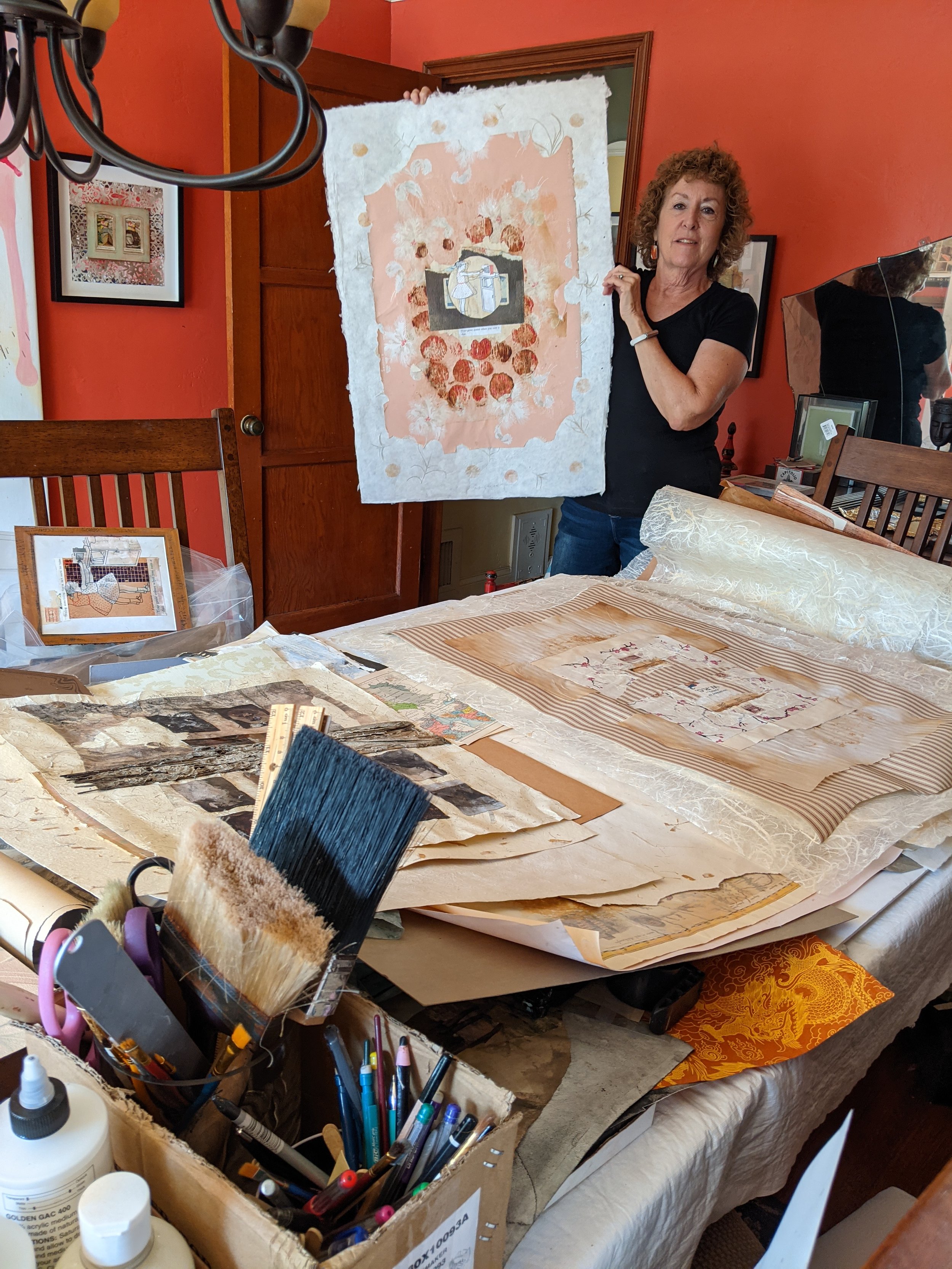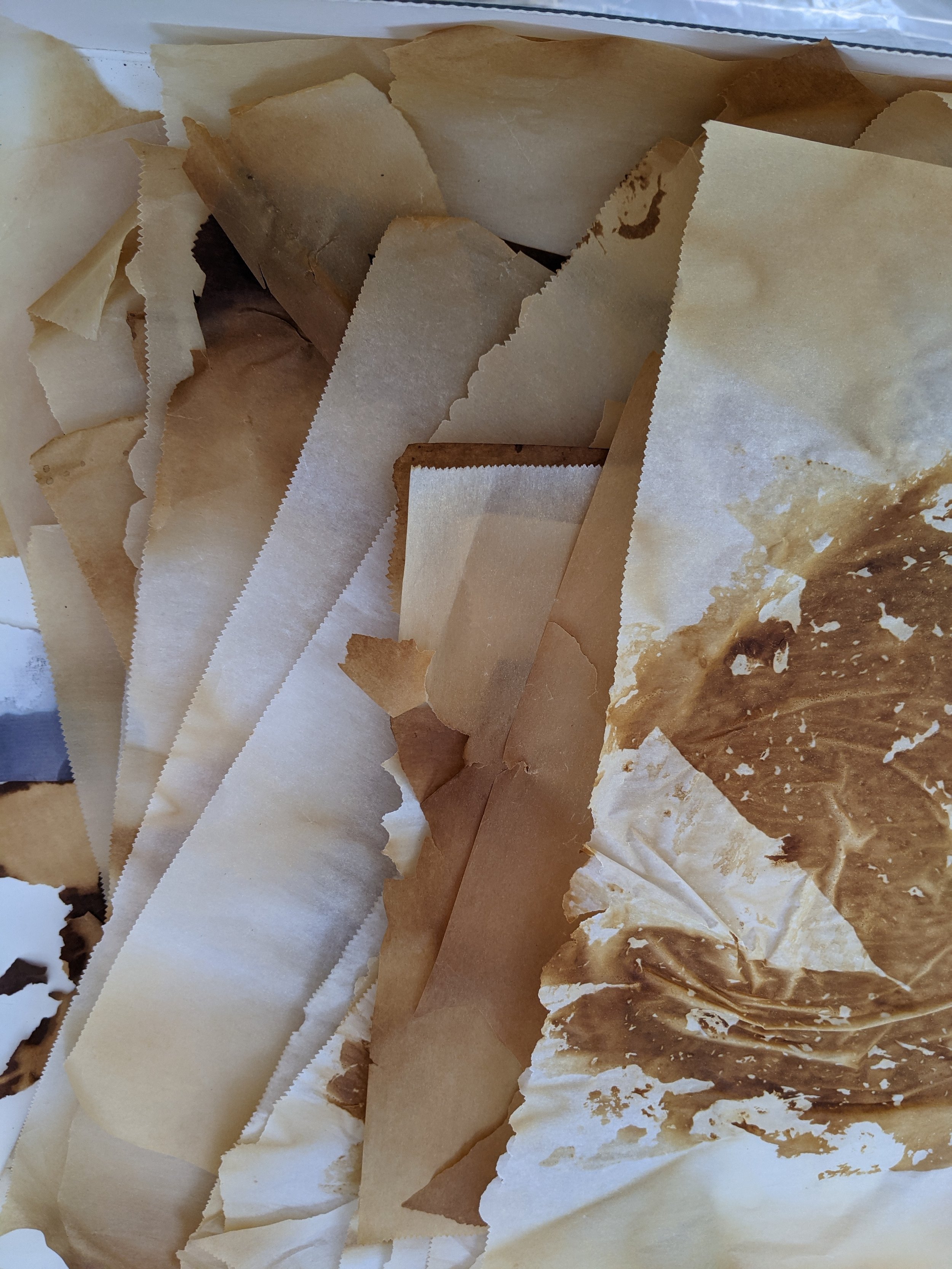A Visit with Nancy Kay Turner, August 2021
THE SPACE
Nancy Kay Turner’s creative space is full.
Her pandemic-era work occupies three tables and other pieces of furniture. Her workspaces, inside and outside her house, have a packed, concentrated intensity like her work itself.
To me, the concentrated, packed feeling of her work environment, sandwiched into her living space, seems fertile and energized. The house itself is a complex lived environment, and the artwork is a vibrant part of the domestic space.
Nancy Turner in her home studio.
FOUND MATERIALS
The found materials that Nancy uses in her artwork has been discarded because their function has been fulfilled. Nancy saves these fragments from destruction, lives with them, then layers and combines them and finally presses them into a new visual poem.
These collage raw materials are everywhere, spilling out of plastic bins, treasure boxes and old rusty tins. They are discarded scraps of materials whose task has been completed. Some are recent scraps from her kitchen, like parchment paper that was stained brown by the Covid-era bread baked on it. Or there are pieces of old wax paper that Nancy “distressed” with ink, water and sun. Some elements come from old magazines, wallpaper samples, cookbooks and instruction pamphlets. These are funny or sweet or weird or funky, and also worn out but far from dead.
Turner working on distressed paper in her yard.
Parchment paper collected after baking bread.
Her archives also contain 19th century photos, tintypes, letters, trinkets and cards. Touching these was very moving, because I knew that these pieces of paper had been handled by living people, who invested in them their experiences and feelings, or saved vestiges of loved ones lost. Fibers from their clothing and bits of their skin probably still clung to the paper.
After years passed, there was no one left for whom these relics had meaning. These leftovers, curios, and residues passed from hand to hand until Nancy Turner found them in a yard sale, or got them from someone who no longer knew what to do with them.
From Turner’s archive of collage materials.
Found Materials.
These older collage materials carry emotional weight and aura. They are so much more potent than regular art supplies. For example, compared to the collage fragments, paint in its jar seems one-dimensional. The color saturation of pigment is deep and rich, but it is a different thing all together from touching and reading Civil War-era letters, even if we know nothing of the people involved. Bits of sentences in near-calligraphic script read like poetry of distance and loss: “… hardly know how you look…” or “… mother.”
PAPERS AND PAINT AND PANELS
While collage is the most obvious element of Nancy’s work, she also uses wood panels or heavy paper as a means of framing or providing a foundation for her works.
She ages and works these conventional art materials to complement her collages. Abstract or gestural paint lend an overall mood to the work, sometimes playful, sometimes ominous. Many works are mounted on beautiful papers with mulberry fibers. Other works are built up on very contemporary, synthetic Yupo paper, heavily worked over with ink. Other works with more 3-dimensional elements are on cradled wood panels.
Synthetic and natural papers, aged with inks and dyes.
Her flat artworks on paper are perhaps the closest to conventional collages. Other more substantial works, like relief sculptures on wood panels encrusted with curios, mementos and framed photos. She also produces books, which are time-based experiences for the viewer, although time may not be linear in them, and may run forward, backwards or in circles.
Flat collage work.
Collage that resembles relief sculpture and assemblage.
THE ARTWORK
Looking through Nancy’s stand-alone collages or paging through those in book form is like going on a trip. Welcome to the stubborn persistence of life, the poignancy of decay, the transformations caused by time, and the embodiment of memory in objects we make.
Take for example these two artworks. Grids often underly Nancy’s works, which references the boxes that contain archival material and also the spatial organization behind many systems. Because of this, two works, like An Immovable Veil of Black and Luck of the Draw, which couldn’t be more different, nevertheless feel linked and share a common aesthetic.
Once past the structural similarities and the common color palette, there is a whole world of memories to explore. The left work, An Immovable Veil of Black, looks like a ruin, a place of disaster, a house of dead souls. The images are cards from an artist’s deck that featured mutants or freaks which Nancy dyed until they transformed. What seems to be a burnt plank is a piece of paper that she found in the street, water-soaked and water-transformed.
The work on the right, Luck of the Draw, seems much more intact and less distressed. All elements are mounted on handmade paper embedded with dried flower petals. There are patterned papers and a photo of a smiling woman, all only slightly aged. Yet her eyes are blocked and she seems distant and unreachable. The five tiles surrounding her are from mah-jongg, a game that required skills, observation, adaptive strategies, and memory, but also with a fundamental element of chance. What was this woman’s fate?
Left, An Immovable Veil of Black, mixed media with found water-altered paper and playing cards. Right, Luck of the Draw, mixed media with found vintage postcards and vintage Chinese mah-jongg tiles.
I loved visiting Nancy’s studio. Everything in her life rolls together in this combined living and creative space. Snippets of text from her collages are suddenly echoed on the evening news. Daily life, love and disaster from long ago are folded into today’s events, layered one on top of the other, like kneaded dough. Time seems to repeat itself.
The recurring motif of layers keeps returning to me: the layers of raw materials on Nancy’s work table; the layers of artworks, stacked one on another; the layers of pages in a book; and within each individual work, the layers of elements that make links, make associations, and leave as many questions as answers. Here are the words that came to me.
Relics
Vestiges
Artifacts
Curiosities
Remains
Keepsakes
Evidence
Heirlooms
Souvenirs
Mementos
Traces
Memorials
Her works all becomes visual poems.
--Margaret Lazzari, 2021








